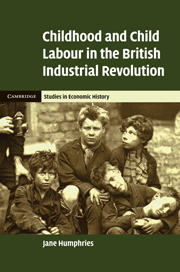8 - Jobs
Published online by Cambridge University Press: 06 December 2010
Summary
Introduction
While continuing to exploit the rich detail on early employment, this chapter turns attention from age and circumstances of starting work to the jobs undertaken, and to recruitment, remuneration and motivation. The chapter begins by identifying the most popular jobs for children and exploring how these related to adult jobs and to the organization of work. Next, the distribution of first jobs is compressed into the same broad occupational categories used earlier, and these are studied over time and in comparison with fathers' jobs to uncover the differences between child and adult labour and how these differences developed. Comparisons can test for the emergence of an exclusively child labour market devoted to part-time and seasonal work and marginal to the main industrial and agricultural activities and so establish whether the mid-nineteenth century saw an ‘adulting’ of the labour force and the segmentation and ultimate disappearance of children's work (Coninck Smith et al., 1997; Cunningham, 2000).
Inter-generational comparisons between fathers' and sons' occupational distributions highlight the micro-processes at work in the restructuring of the British economy during the industrial revolution. The extent to which sons in particular groups followed in their fathers' footsteps and fathers in particular groups recruited their sons suggests different patterns of expansion and contraction and different levels of self-recruitment across the occupational groups.
- Type
- Chapter
- Information
- Childhood and Child Labour in the British Industrial Revolution , pp. 210 - 255Publisher: Cambridge University PressPrint publication year: 2010

